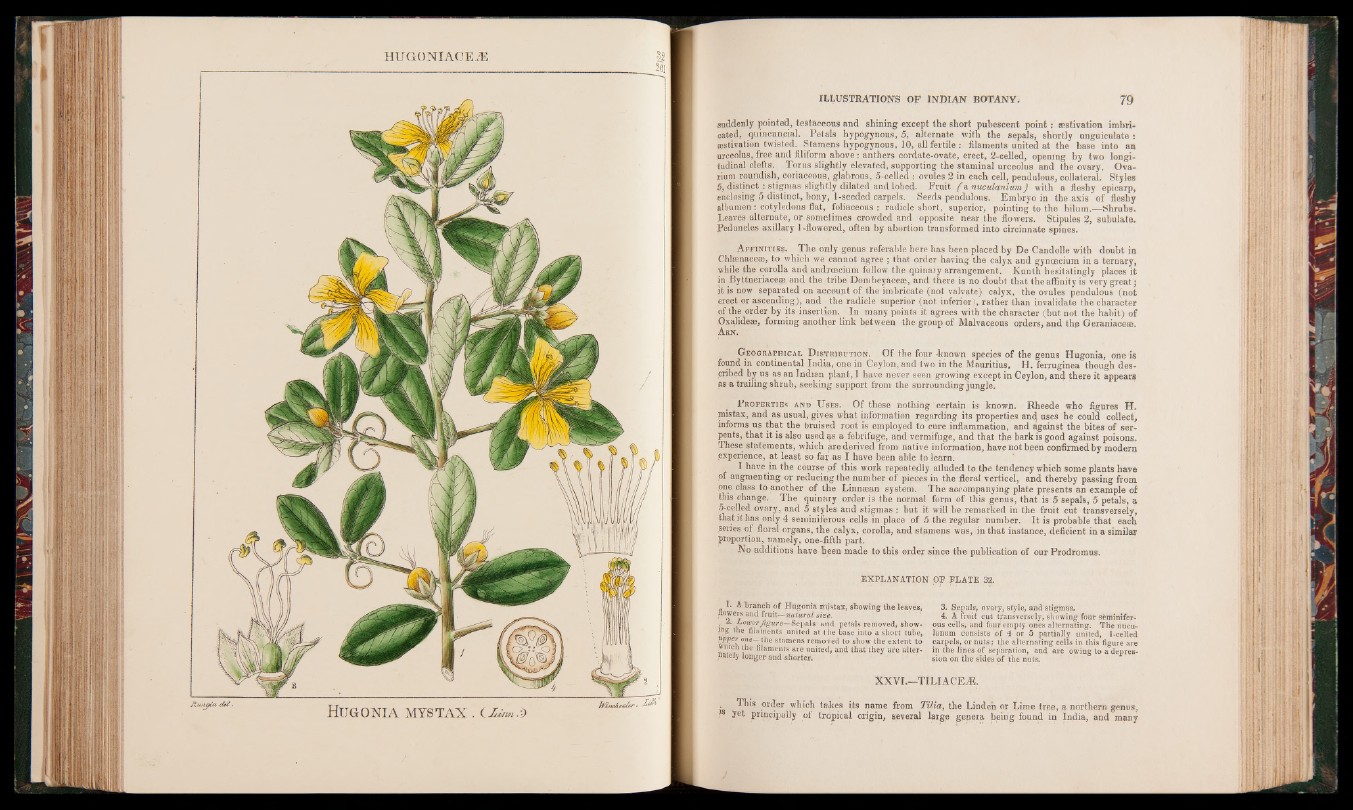
HUGONIACEÆ
Hu g o n ia MYSTAX . H |
suddenly pointed, testaceous and shining except the short pubescent point: «estivation imbricated,
quincun,cial. Petals hypogynous, 5, alternate with the sepals, shortly unguiculate :
«estivation twisted. Stamens hypogynous, 10, all fertile : filaments united at the base into an
urceolus, free and filiform above : anthers cordate-ovate, erect, 2-celled, opening by two longitudinal
clefts. Torus slightly elevated, supporting the staminal urceolus and the ovary. Ovarium
roundish, coriaceous, glabrous, 5-celled : ovules 2 in each cell, pendulous, collateral. Styles
5, distinct : stigmas slightly dilated and lobed. Fruit ( a nuculanium) with a fleshy epicarp,
enclosing 5 distinct, bony, 1-seeded carpels. Seeds pendulous. Embryo in the axis of fleshy
albumen : cotyledons flat, foliaceous : radicle short, superior, pointing to the hilum.—Shrubs.
Leaves alternate, or sometimes crowded and opposite near the flowers. Stipules 2, subulate.
Peduncles axillary 1-flowered, often by abortion transformed into circinnate spines.
A f f in it ie s . The only genus referable here has been placed by De Candolle with doubt in
Chlaenaceae, to which we cannot agree ; that order having the calyx and gyncecium in a ternary,
while the corolla and androecium follow the quinaiy arrangement. Kunth hesitatingly places it
in Byttneriaceae and the tribe Dombeyacem, and there is no doubt that the affinity is very great;
it is now separated on account of the imbricate (not valvate) calyx, the ovules pendulous (not
erect or ascending), and the radicle superior (not inferior), rather than invalidate the character
of the order by its insertion. In many points it agrees with the character (but not the habit) of
Oxalideae, forming another link between the group of Malvaceous orders, and the Geraniaceae.
Arn.
G eographical D istr ibu t ion. Of the four «known species of the genus Hugonia, one is
found in continental India, one in Ceylon, and two in the Mauritius, H. ferruginea though described
by us as an Indian plant, I have never seen growing except in Ceylon, and there it appears
as a trailing shrub, seeking support from the surrounding jungle.
P ro p erties and U s e s . Of these nothing * certain is known. Rheede who figures H.
mistax, and as usual, gives what information regarding its properties and uses he could collect,
informs us that the bruised root is employed to cure inflammation, and against the bites of serpents,
that it is also used as a febrifuge, and vermifuge, and that the bark is good against poisons.
These statements, which are derived from native information, have not been confirmed by modern
experience, at least so far as I have been able to learn.
I have in the course of this work repeatedly alluded to the tendency which some plants have
of augmenting or reducing the number of pieces in the floral verticel, and thereby passing from
one class to another of the Linnsean system. The accompanying plate presents an example of
this change. The quinary order is the normal form of this genus, that is 5 sepals, 5 petals, a
5-celled ovary, and 5 styles and stigmas : but it will be remarked in the fruit cqt transversely,
that it has only 4 seminiferous cells in place of 5 the regular number. It is probable that each
series of floral organs, the calyx, corolla, and stamens was, in that instance, deficient in a similar
proportion, namely, one-£fth part.
No additions have ’been made to this order since the publication of our Prodromus.
EXPLANATION OF PLATE 32.
. *juwerjigure—oepais ana petals removed, sr
?ng the filaments united at the base into a short t
PPpcr one— the stamens removed to show the exter
which the filaments are united, and that they are a
uateiy longer and shorter.
3. Sepals, ovary, style, and stigmas.
4. A fruit cut transversely, showing four seminiferous
cells, and four empty Ones alternating. The nucu-
lanum Consists of 4 or 5 partially united, 1-celled
carpels, or nuts; tfie alternating cells in this figure are
in thé lines of separation, and are owing to a depression
on the sides of the nuts.
XXVI.—TILIACELE.
This order which takes its name from Tilia, the Linden or Lime tree, a northern genus,
8 yet principally of tropical origin, several large genera being found in India, and many